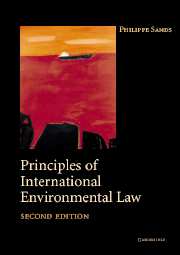Book contents
- Frontmatter
- Contents
- Foreword
- Preface and acknowledgments to the first edition
- Preface and acknowledgments to the second edition
- Table of cases
- Table of treaties and other international instruments
- List of abbreviations
- PART I The legal and institutional framework
- PART II Principles and rules establishing standards
- PART III Techniques for implementing international principles and rules
- 16 Environmental impact assessment
- 17 Environmental information
- 18 Liability for environmental damage
- 19 International trade and competition
- 20 Financial resources, technology and intellectual property
- 21 Foreign investment
- Index
18 - Liability for environmental damage
- Frontmatter
- Contents
- Foreword
- Preface and acknowledgments to the first edition
- Preface and acknowledgments to the second edition
- Table of cases
- Table of treaties and other international instruments
- List of abbreviations
- PART I The legal and institutional framework
- PART II Principles and rules establishing standards
- PART III Techniques for implementing international principles and rules
- 16 Environmental impact assessment
- 17 Environmental information
- 18 Liability for environmental damage
- 19 International trade and competition
- 20 Financial resources, technology and intellectual property
- 21 Foreign investment
- Index
Summary
Introduction
General principles of international law imposing liability on actors for their illegal acts, or for the adverse consequences of their lawful activities, are relatively well developed at a general level, and are now reflected in the Articles on State Responsibility adopted by the ILC in 2001. In relation to environmental damage, however, the liability rules are still evolving and in need of further development. Environmental damage refers here to damage to the environment, which has been defined in treaties and other international acts to include four possible elements: (1) fauna, flora, soil, water and climatic factors; (2) material assets (including archaeological and cultural heritage); (3) the landscape and environmental amenity; and (4) the interrelationship between the above factors. Most legal definitions of environment do not, therefore, include people and their property.
Liability rules at the domestic or international level serve a variety of purposes. They may be a form of economic instrument which provides an incentive to encourage compliance with environmental obligations. They may also be used to impose sanctions for wrongful conduct, or to require corrective measures to restore a given environmental asset to its pre-damage condition. Finally, they may provide a technique for internalising environmental and other social costs into production processes and other activities in implementation of the polluter-pays principle.
- Type
- Chapter
- Information
- Principles of International Environmental Law , pp. 869 - 939Publisher: Cambridge University PressPrint publication year: 2003



